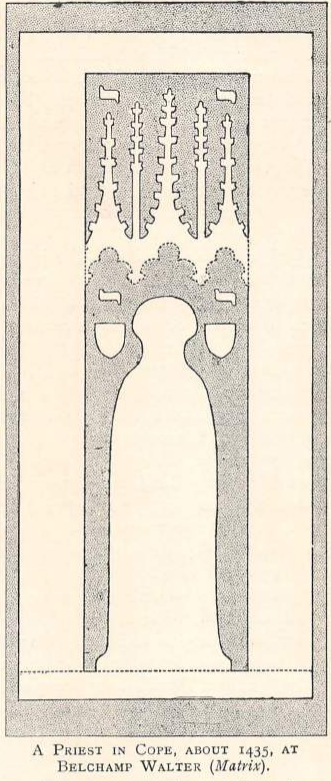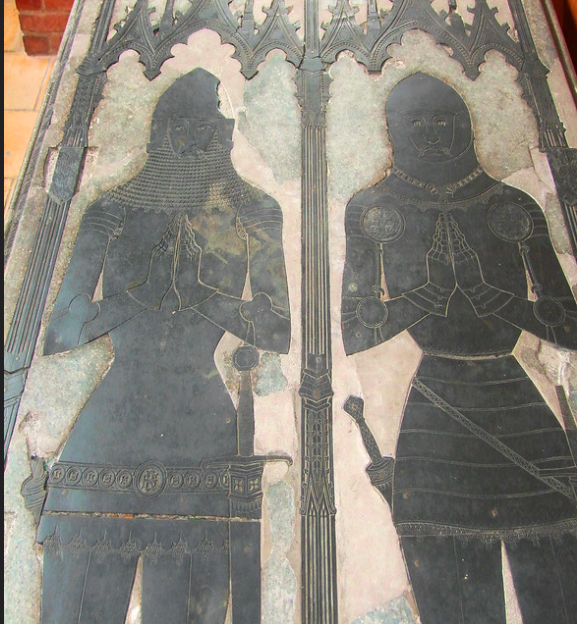Webmaster Notes
While the ESAH stated that the brasses for which only the matrices remain at St. Mary's are not known, Martin Stuchfield definitly says that the knight (soldier in the ESAH description) is Sir Robert Swynbourne.
The identity of the pair, described as brothers, is guessed. I can see no reason why this would be the case. If brothers I would further add that the priest was that of Belchamp Walter church at the time and his brother, if Sir Robert, was also living in Belchamp Walter at the time and may have also held the Advowsen for the village.
I have placed printing formatting codes on this page to allow the printing of the martix information without the webpage "clutter".
The Monumental Brasses of St. Mary's
There were two monumental brasses that are documented as being found in
the Church of
St. Mary Belchamp Walter. These have sadly been removed and only the stone matrices (Incised Slabs)
remain and are in poor condition.
The account of the brasses are taken from the Essex Society for Archaeology &
History Transactions - Vol VIII Part 1, 1900.
If you scroll down the page you will see a description of what they are and
once looked like.
First Matrix
Top
The first brass is the matrix (the stone slab) that once had the brass of a man in armour and a priest
in the Church of St. Mary's Belchamp Walter.
The text from the
Essex Archaeological Society" - "Some Interesting Essex Brasses".
BELCHAMP WALTER, 1 Effigies of a Man in Armour and an
Ecclesiastic, beneath fine double - Canopy; with Foot-legend and four Shields.
Matrices only now remaining.
Date about 1425.
This fine and large composition, the matrix of which is much defaced,
lies in the central aisle of the nave. Its most remarkable feature lies
in the fact that it portrayed both a soldier and a priest, doubtless
brothers. The only other instance of this to be found in the county is
a matrix (which we have already figured'), of about the year 1490, at
Pleshey. The slab measures 88 inches long by 36 inches broad.
The effigy of the soldier (32½ inches in height), placed on the dexter side, represented him in the
complete plate armour of the Lancastrian Period.
The priest (32½ inches in height) occupies the sinister side.
The canopy (59½ inches in height) is supported on slender side - shafts and
consists of two cusped arches terminating above in crocketted finials, with pinnacles on each side and
in the centre.
The inscription (32½ inches by 3¾ inches) was placed below the feet of the figures, and the canopy
rises from it.
The shields (each five inches in height) are placed two above and two below the effigies.
To attempt to guess who the individuals commemorated may have been ·would be futile.

Text and plate from: Transactions of the Essex Archaeological Society
Vol III part 1 - 1900
Two Essex Incised Slabs.
By Miller Christy And E. Bertram Smith.
While EASH say that the identification of the individuals would be futile it
could be that may be related to a Botetourt.
Second Matrix
The second incised slab is supposedly "exceedingly worn". Never-the-less it is now under the carpet in the
central aisle of the Church.

BELCHAMP WALTER, II.- [ Effigy of a Priest in Cope, beneath fine Canopy; with Foot-legend; two Shields, and
four Scrolls]. Matrices only now reinaimng.
Date about 1435.
This fine and large composition, the matrix of which is exceedingly worn, lies (like the slab noticed above)
in the central aisle of the nave. We have no trace in the county of any brass of similar
character. The slab measures no less than 100 inches long by 44½ inches broad.
The effigy of the priest (52 inches in height) is fourteen inches higher than our only other ancient example of a coped priest-that of "William Kyrkeby, 1458, at Theydon Gernon.
The canopy (94 inches in total height) is triple and in two tiers. The lower tier terminates above in three crocketted finials and two pinnacles. The side-shafts, which are of very unusual width (about nine inches), support the upper tier-a deep rectangular entablature, perhaps battlemented at the top. The extensive surface of the side-shafts and upper tier of the canopy was occupied, doubtless, by figures of saints and ornamental
tracery.
The two shields (each 4½ inches in height) are placed on either side of the priest's head.
Of the scrolls, which are small (only 3 inches in length), two are placed above the shields and two below the super-canopy.
The outlines of the foot legend are for the most part defaced.
We have no idea who the priest represented may have been.
Newcourt throws no light upon the point.
The identities of those memorialised
While we will probably never know who these were, we do know that a descendant of Sir John Gernon was married to a son or grandson of
Robert_Swynborne.
Joan Gernon was married of Sir John de Botetourt who (or his grandson) are memorialised in the chantry chapel that was in the church.
The vicar (priest) in 1403 was John Crispe (according to Church records):
Church records: - the church guide
In the year 1559 Queen Elizabeth I ordered registers to be kept in all Churches.
In 1623 William Smythies was appointed Vicar. He not only kept the registers most beautifully, but also copied out entries of his predecessors from 1559 onwards in a vellum bound book. The current registers are preserved in the Church safe, but the older registers are kept in the Essex County Archives.
William Smythies recorded that John Crispe was the priest in 1403 and is most likely to have been the incumbent at the time of the installation of the tombs and brasses. If the two individuals were brothers the soldier was associated with Colne Priory.
Update: November 2024
When the tomb matrices were inspected by Martin Stuchfield the first matrix is definitly that of Sir Robert Swynbourne and his brother, the priest of the parish at the time John Crisp.
If this is the case the date of the Chantry Chapel would be dated to the middle to late 15th Century. This would be just later than the estimated dating of the Medieval Wall Paintings (being arond being 1440)
Sir Robert Swynbourne and Sir John de Botetourt, 2nd Lord, both fought in the Hundred Years War. Their armour is
indicative of the period.
Other interesting brasses at Brightlingsea
Are also described in the ESAH article.
A third tomb in the aisle
A floor memorial to Anne Raymond with of John Eden, daughter of Oliver and Frances Raymond.
Anne was one of Oliver and Frances' Twenty One children she was first married to John Lawrence.
She married John Eden at an unknown date, the date on the memorial is 16??.
Sir Robert Swynbourne in Lancastrian armour
Newcourt's Repertorium
Full Title:
Repertorium Ecclesiasticum Parochiale Londinense: Comprising all London and Middlesex,
with the parts of Hertfordshire and Buckinghamshire to the said diocese belonging
Richard Newcourt, (died 1679) was an English topographical draughtsman and cartographer.
He reproduced effigies of the clergy that had been found memorialised in tombs and brasses. He is quoted
by the EASH article about the incised slabs.
Richard Newcourt was a was a friend of Sir William Dugdale, and drew some views of religious houses,
which were engraved for Dugdale's Monasticon Anglicanum.
INCISED SLAB AT MIDDLETON, ESSEX, TO SIRE JAMES SAMSON, RECTOR OF THE PARISH, WHO DIED IN 1349.




